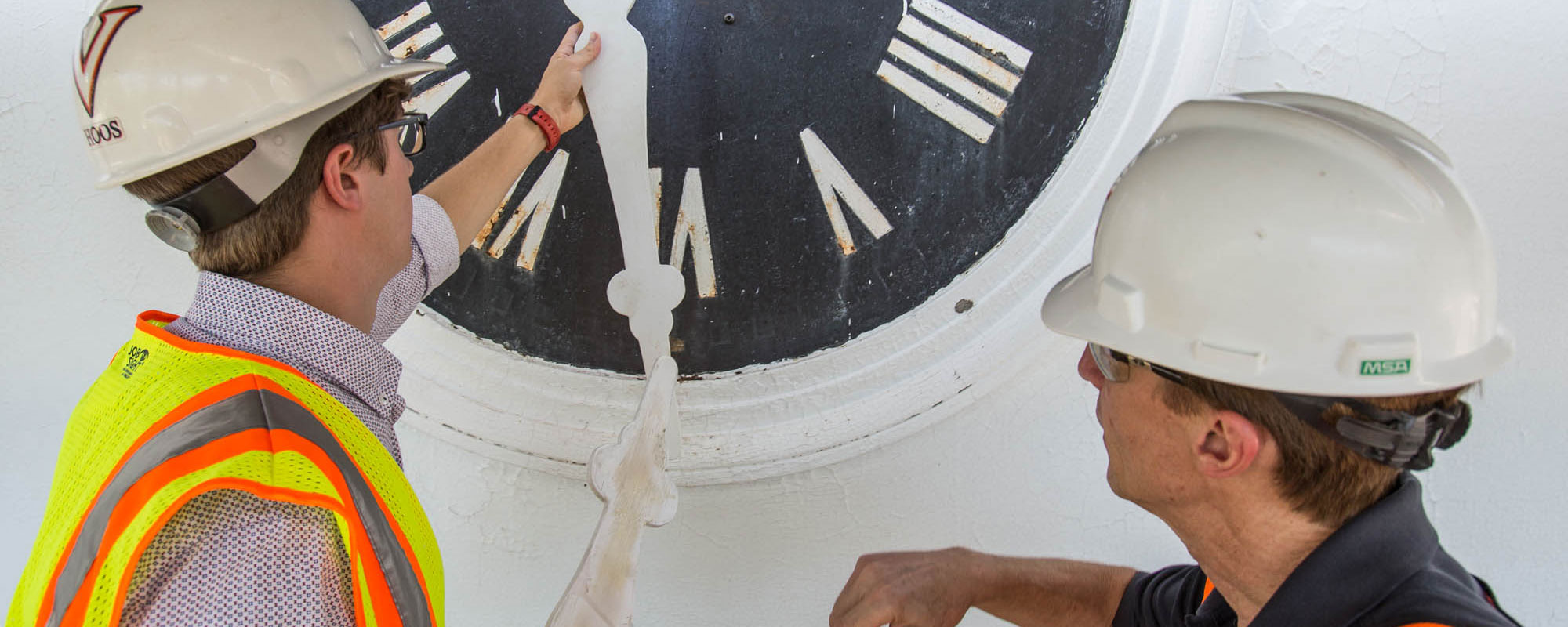New century, new clocks.
As part of the ongoing renovation of the University of Virginia’s iconic Rotunda, workers will completely replace the clocks in the north and south porticos, installing new clock works, new hands and new dials. The new, aluminum clock faces will be painted to resemble the 1890s dials.
“The new clock face will be black with gilded numerals,” said Mark Kutney, an architectural conservator in the Office of the Architect for the University. “The new dial will be an aluminum plate that will encapsulate and protect the old face. There will be a very thin layer of buffering material between the iron face and the new aluminum one to protect the original painted design.”
Leaving the clock dials in place is an important element in preserving them.
“If we removed the dials from the building, we would be removing them from their original context,” Kutney said. “If the dials ever left the University, this context would be lost.”
The clocks will have new works to operate the system, and will provide automatic seasonal time changes, time resetting after a power failure and “minute impulse signals” – extending longevity of the movements, as each motor only operates for four seconds each minute. System accuracy will be plus or minus four minutes per year.
Kutney said it would be difficult and expensive to put the existing clock mechanisms into working condition again and that they have been hard to maintain.
“The reason you see IIII, and not IV, is due to a royal decree centuries ago that four I’s would balance the right side of the dial with the VIII on the left side of the dial. It has traditionally been that way ever since.” - Bob Desrochers
“They have been severely altered twice since they were originally installed, and many of the original parts are missing,” he said. “We looked at our options and decided to replace the mechanisms with a nearly zero-maintenance modern clock works.”
He said every part of the old clocks will be preserved, either in an archive maintained by the Office of the Architect or on the building.
University founder Thomas Jefferson commissioned Boston clockmaker Simon Willard to construct the original Rotunda clock, and the two men exchanged letters outlining the specifications. Willard and Jefferson’s clock was 60 inches across the dial face, and the bezel – the ring around the outside of the clock – was 10 inches wide. This clock dominated the pediment of the south portico, facing the Lawn and the Academical Village. There was no clock on the north side of the original Rotunda, but when the ill-fated Annex was built in the early 1850s, there was an exterior clock on its north end.
The Willard clock was destroyed in the 1895 fire that heavily damaged the Rotunda, and when New York architect Stanford White re-envisioned the Rotunda, he commissioned a slightly smaller model from E. Howard and Co., clockmakers of Boston. The Howard clock had a 55-inch dial face and 5½-inch bezel. White ordered two clocks, one for the south portico and a matching one for the north portico.
Conservators working on the Rotunda believe the Howard clocks’ colors to be similar to the Willard timepiece and they will be echoed in the latest version.
The original Howard clocks had pierced, ornate hands, which were replaced at some point with less elaborate wooden hands, possibly during the 1970s renovation. New aluminum hands will be made for the two clocks. The hands will be powder-coated matte white, then gilded.
“The original [Howard] hands may have been made of copper,” Kutney said. “We are looking at today’s choice of materials for performance, durability and best value. Aluminum is the better choice.”
The new clock faces will look like the old, including using “IIII” to represent 4 o’clock on the dial. Bob Desrochers, an expert clock and watchmaker who is consulting with the University on the Rotunda clocks, said “IIII” is traditional.
“The reason you see IIII, and not IV, is due to a royal decree centuries ago that four I’s would balance the right side of the dial with the VIII on the left side of the dial,” he said. “It has traditionally been that way ever since.”
The two Howard clocks originally were controlled by a master clock at Rouss Hall, which housed the physics lab at that time. A single wire circling the Academical Village linked the clocks and class bells in every academic building – a system prone to failure. Similar to a string of Christmas lights, if one bell malfunctioned, the entire system failed. One short circuit or break in the wire would cause the clocks to gain time rapidly or stop completely.
In 1922-23, physics professor Llewellyn G. Hoxton and a department employee, Arthur J. Reed, revamped the faulty clock and bell system, rebuilding the Rotunda clocks to be regulated by weights and pendulums while still being electrically set by the Rouss Hall clock. They also replaced the class bells to be much sturdier, and inserted a more reliable wiring system.
The Rotunda timepieces were electrified again on Oct. 23, 1948, by Town Clock Service Co. of Springfield, Ohio, according to notations made on the walls near the mechanisms.
Media Contact
Article Information
November 4, 2015
/content/switch-time-rotunda-get-new-clocks-renovation

